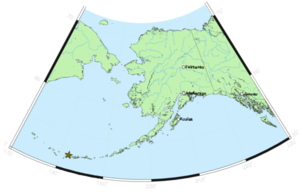Tanaga Island



Tanaga Island (Tanax̂ax[2] in Aleut) is an island in the western Andreanof Islands, in the southwest part of the Aleutian Islands, Alaska. The island has a land area of 204 square miles (530 km2), making it the 33rd largest island in the United States. Its highest point is volcano Mount Tanaga at 5,925 feet (1,806 m), called Kusuuginax̂[2] in Aleut.
Tanaga Island is about 62 miles west of Adak Island, the nearest inhabited island. There are several large waterfalls on Tanaga Island. Tanaga Island is uninhabited, but several cabins are shown on the NOAA nautical chart, as well as some Aluet villages on the east side of the island.[3]
There are no native land mammals on Tanaga Island.
Tanaga Island was established as a Navy emergency landing field in July 1943 as an adjunct to the Adak Naval Operation Base. Navy Seabees built a runway, small-craft pier, mooring area, office and storage buildings, radio building, galley and mess facilities, dispensary, and 4 miles of gravel road in 1943, near Lash Bay in the southwest of the island. The site was abandoned in 1945. The control tower is still shown on nautical charts.
Volcano
The last known eruption of Tanaga Volcano occurred in 1914. Earlier eruptions were reported in 1763-1770, 1791, and 1829. Reports of these eruptions are vague, but deposits on the flanks of the volcano show that typical eruptions produce blocky lava flows and occasional ash clouds.
Eruptions have occurred both from the summit vent and a 5,197 ft-high satellite vent on the volcano's northeast flank. Immediately west of Tanaga volcano lies Sajaka, a 4,443 ft-high compound edifice.
Takawangha's 4,754 ft-high summit is mostly ice-covered, except for four young craters that have erupted ash and lava flows in the last few thousand years. Parts of Takawangha's edifice are hydrothermally altered and may be unstable, and could produce localized debris avalanches. No historical eruptions are known from Sajaka or Takawangha; however, field work shows that recent eruptions have occurred and it is possible that historic eruptions attributed only to Tanaga may instead have come from these other vents.[1]
References
- ^ a b c Alaska Volcano Observatory - Tanaga
- ^ a b Bergsland, K. (1994). Aleut Dictionary. Fairbanks: Alaska Native Language Center.
- ^ Nautical Chart containing Tanaga Island
External links
- Tanaga Island Photos Photos from Tanaga Island, July 2008]